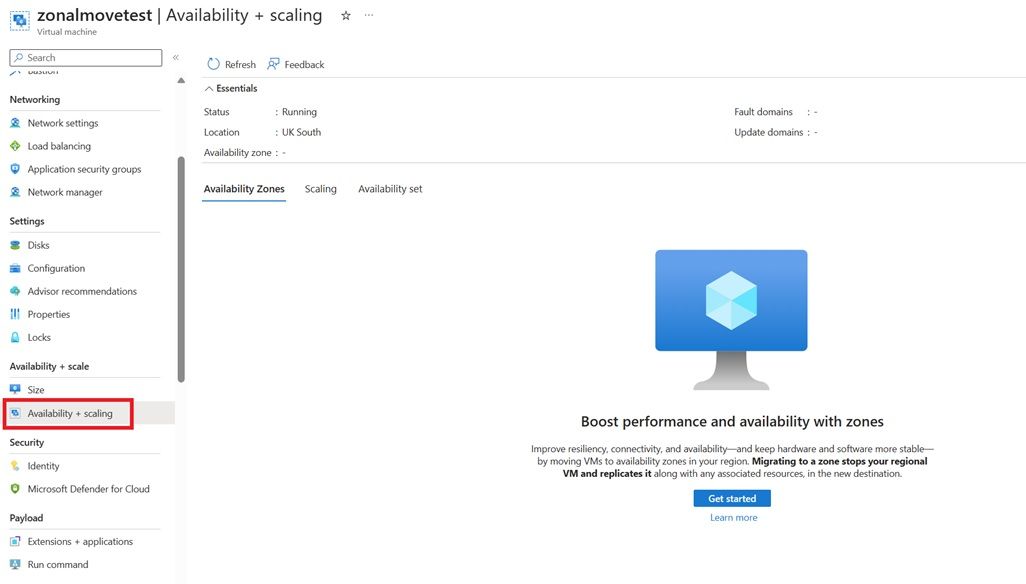Public Preview Announcement: Azure VM Regional to Zonal Move

Authors: Kaza Sriram, Senior Product Manager
We are excited to announce the public preview of single instance VM regional to zonal move, a new feature that allows you to move an existing VM in a regional configuration (deployed without any infrastructure redundancy) to a zonal configuration (deployed into specific Azure availability zone) within the same region. This feature announcement continues the momentum with our earlier announced VMSS Zonal expansion features and reinforces the Azure wide zonal strategy, that enables you to take advantage of higher availability with Azure availability zones and make them an integral part of your comprehensive business continuity and resiliency strategy.
This feature is intended for single instance VMs in regional configurations only and not for VMs already in availability zones, or VMs part of an availability set (AvSet) or Virtual Machine Scale Sets (VMSS).
Benefits
- This capability allows you to move your existing regional VMs into availability zones that were not available when the VM was created in your region of choice, and increase application resiliency and availability supported by 99.99% uptime SLA for virtual machines, that have two or more instances deployed across two or more availability zones.
- You can orchestrate the move at scale for multiple VMs simultaneously, while still leveraging existing infrastructure such as VNETs, Subnets, NSGs, LB etc. which can support target zonal configuration.
- This feature also provides a built-in dependency analysis to identify the dependent resources of the VM (E.g.: VNET, Public IPs, NICs etc.) and makes the migration workflow much simpler.
- The VM Regional to Zonal Move preview will initially be available in Azure public regions with support for sovereign regions to follow. Please check our documentation for the latest list of supported regions.
How does it work?
- Upon specifying the target zone number for the VM(s), a built-in dependency analysis is done to identify the dependent resources of the VM (E.g.: VNET, Public IPs, NICs etc.).
- A copy of the source VM and disk is created in the specified availability zone (within the same region) and the source VM is shut down and configuration left intact, to ensure a seamless roll back and no data loss move. There will be a brief downtime of few minutes during the move process.
- You can leverage the Single Instance VM Regional to Zonal Move capability through a variety of means including Azure Portal, Azure CLI, Azure PowerShell, and Azure SDKs.
Portal
- The following image illustrates how to use Azure portal to configure an existing single instance VM to zonal configuration.
Learn More
Learn more about the VM Regional to Zonal Move and try the preview today!
Published on:
Learn moreRelated posts
Introducing Azure OpenAI Realtime API Support in JavaScript
Introducing the new Realtime API support in the OpenAI JavaScript library, enabling developers to create highly interactive and responsive app...
Full web support for conditional access policies across Azure DevOps and partner web properties
We’re happy to announce that we’ve made significant progress in updating our web authentication stack on Azure DevOps services and partner web...
Doctors generate faster, more accurate medical charts with Sayvant and Azure Cosmos DB
This article is guest authored by Justin Mardjuki, CEO, Sayvant. Emergency rooms and urgent care facilities handle an estimated 350 million vi...
Update to Azure DevOps Allowed IP addresses
We are excited to announce some important upgrades to our networking infrastructure that will enhance the performance and reliability of our s...
Azure SDK Release (January 2025)
Azure SDK releases every month. In this post, you find this month's highlights and release notes. The post Azure SDK Release (January 2025) ap...
Announcing AMQP v2 stack engine support in the Azure Messaging Event Hubs library for Java
This blog post announces a new stable release of the Azure Event Hubs library for Java, with enhanced reliability and performance. The post An...

